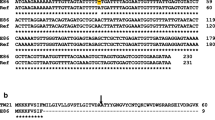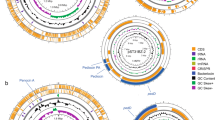Abstract
A class IIa bacteriocin pediocin can be used in food biopreservation due to its high activity against foodborne pathogens, such as Listeria monocytogenes. In this study, pediocin-resistant L. monocytogenes variants were generated, and different properties of the mutants were compared with wild-type L. monocytogenes. Bacteriocin-resistant Listeria variants were selected on BHI agar containing pediocin. Susceptibility of Listeria strains to different bacteriocins and antibiotics were tested by agar well diffusion method. Growth properties were monitored by recording absorbance at 600 nm. Changes in cell properties were evaluated by determining cell surface hydrophobicity and adsorption of pediocin onto Listeria cells. Transcriptional levels of mptA gene in wild-type and mutant strains were quantified by real-time PCR. Mutations in DNA were examined by sequencing. The two stable resistant variants were less sensitive also to class IIa bacteriocins, but not to nisin and ampicillin. In BHI broth supplemented with glucose or mannose, the wild-type strain grew faster than the resistant variants, whereas with cellobiose, the mutants grew better. The bacteriocin-resistant cells showed increased hydrophobicity, as well as lower adsorption of pediocin on cell surface than wild-type Listeria. Significant downregulation of mptA gene was observed in Lmo-r2 variant but not in Lmo-r5 variant. However, no mutations in the regulatory genes resD and lmo0095 of the variants were observed, and only minor changes were found in upstream region of the mpt operon. These results demonstrated differences in growth, carbohydrate utilization, cell surface, and gene transcription between wild-type and pediocin-resistant strains. This makes it evident that bacteria can use various and complex ways to acquire resistance to antimicrobial compounds.






Similar content being viewed by others
References
Arous S, Dalet K, Héchard Y (2004) Involvement of the mpo operon in resistance to class IIa bacteriocins in Listeria monocytogenes. FEMS Microbiol Lett 238:37–41
Cotter PD (2014) An ‘Upp’-turn in bacteriocin receptor identification. Mol Microbiol 92:1159–1163
Cotter PD, Hill C, Ross RP (2005) Bacteriocins: developing innate immunity for food. Nat Rev Microbiol 3:777–788
Crandall AD, Montville TJ (1998) Nisin resistance in Listeria monocytogenes ATCC 700302 is a complex phenotype. Appl Environ Microbiol 64:231–237
Dalet K, Arous S, Cenatiempo Y, Héchard Y (2003) Characterization of a unique σ54-dependent PTS operon of the lactose family in Listeria monocytogenes. Biochimie 85:633–638
Garde S, Avila M, Medina M, Nuñez M (2004) Fast induction of nisin resistance in Streptococcus thermophilus INIA 463 during growth in milk. Int J Food Microbiol 96:165–172
Garsa AK, Kumariya R, Sood SK, Kumar A, Kapila S (2014) Bacteriocin production and different strategies for their recovery and purification. Probiotics Antimicrob Proteins 6:47–48
Gravesen A, Jydegaard Axelsen AM, Mendes da Silva J, Hansen TB, Knøchel S (2002a) Frequency of bacteriocin resistance development and associated fitness costs in Listeria monocytogenes. Appl Environ Microbiol 68:756–764
Gravesen A, Ramnath M, Rechinger KB, Andersen N, Jänsch L, Héchard Y, Hastings JW, Knøchel S (2002b) High-level resistance to class IIa bacteriocins is associated with one general mechanism in Listeria monocytogenes. Microbiology 148:2361–2369
Hyden P, Pietzka A, Lennkh A, Murer A, Springer B, Blaschitz M, Indra A, Huhulescu S, Allerberger F, Ruppitsch W, Sensen CW (2016) Whole genome sequence-based serogrouping of Listeria monocytogenes isolates. J Biotechnol 235:181–186
Kaur G, Singh TP, Malik RK, Bhardwaj A (2012) Mechanism of Nisin, Pediocin 34, and Enterocin FH99 resistance in Listeria monocytogenes. Probiotics Antimicrob Proteins 4:11–20
Kaur G, Singh TP, Malik RK, Bhardwaj A, De S (2014) Antibacterial efficacy of nisin, pediocin 34 and enterocin FH99 against L. monocytogenes, E. faecium, and E. faecalis and bacteriocin cross resistance and antibiotic susceptibility of their bacteriocin resistant variants. J Food Sci Technol 51:233–244
Kjos M, Nes IF, Diep DB (2009) Class II one-peptide bacteriocins target a phylogenetically defined subgroup of mannose phosphotransferase systems on sensitive cells. Microbiology 155:2949–2961
Kjos M, Salehian Z, Nes IF, Diep DB (2010) An extracellular loop of the mannose phosphotransferase system component IIC is responsible for specific targeting by class IIa bacteriocins. J Bacteriol 192:5906–5913
Kjos M, Nes IF, Diep DB (2011) Mechanisms of resistance to bacteriocins targeting the mannose phosphotransferase system. Appl Environ Microbiol 77:3335–3342
Kumariya R, Sood SK, Rajput YS, Garsa AK (2015) Gradual pediocin PA-1 resistance in Enterococcus faecalis, confers cross-protection to diverse pore-forming cationic antimicrobial peptides displaying changes in cell wall and mannose PTS expression. Ann Microbiol 65:721–732
Larsen MH, Kallipolitis BH, Christiansen JK, Olsen JE, Ingmer H (2006) The response regulator ResD modulates virulence gene expression in response to carbohydrates in Listeria monocytogenes. Mol Microbiol 61:1622–1635
Lather P, Mohanty AK, Jha P, Garsa AK, Sood SK (2015) Changes associated with cell membrane composition of Staphylococcus aureus, on acquisition of resistance against class IIa bacteriocin and its in vitro substantiation. Eur Food Res Technol 240:101–107
Liu S, Han Y, Zhou Z (2011) Fusion expression of pedA gene to obtain biologically active pediocin PA-1 in Escherichia coli. J Zhejiang Univ Sci B 12:65–71
Maisnier-Patin S, Richard J (1996) Cell wall changes in nisin-resistant variants of Listeria innocua grown in the presence of high nisin concentrations. FEMS Microbiol Lett 140:29–35
Martínez B, Rodríguez A (2005) Antimicrobial susceptibility of nisin resistant Listeria monocytogenes of dairy origin. FEMS Microbiol Lett 252:67–72
Masias E, Dupuy FG, da Silva Sanches PR, Farizano JV, Cilli E, Bellomio A, Saavedra L, Minahk C (2017) Impairment of the class IIa bacteriocin receptor function and membrane structural changes are associated to enterocin CRL35 high resistance in Listeria monocytogenes. Biochim Biophys Acta Gen Subj 1861:1770–1776
Mehla J, Sood SK (2011) Substantiation in Enterococcus faecalis of dose-dependent resistance and cross-resistance to pore-forming antimicrobial peptides by use of a polydiacetylene-based colorimetric assay. Appl Environ Microbiol 77:786–793
Ming XT, Daeschel MA (1993) Nisin resistance of foodborne bacteria and the specific resistance responses of Listeria monocytogenes Scott A. J Food Prot 56:944–948
Opsata M, Nes IF, Holo H (2010) Class IIa bacteriocin resistance in Enterococcus faecalis V583: the mannose PTS operon mediates global transcriptional responses. BMC Microbiol 10:224
Paul D, Steele C, Donaldson JR, Banes MM, Kumar R, Bridges SM, Arick M 2nd, Lawrence ML (2014) Genome comparison of Listeria monocytogenes serotype 4a strain HCC23 with selected lineage I and lineage II L. monocytogenes strains and other Listeria strains. Genom Data 2:219–225
Pérez PF, Minnaard Y, Disalvo EA, De Antoni GL (1998) Surface properties of bifidobacterial strains of human origin. Appl Environ Microbiol 64:21–26
Porto MC, Kuniyoshi TM, Azevedo PO, Vitolo M, Oliveria RP (2017) Pediococcus spp.: an important genus of lactic acid bacteria and pediocin producers. Biotechnol Adv 35:361–374
Ramnath M, Beukes M, Tamura K, Hastings JW (2000) Absence of a putative mannose-specific phosphotransferase system enzyme IIAB component in a leucocin A-resistant strain of Listeria monocytogenes, as shown by two-dimensional sodium dodecyl sulfate-polyacrylamide gel electrophoresis. Appl Environ Microbiol 66:3098–3101
Robichon D, Gouin E, Débarbouillé M, Cossart P, Cenatiempo Y, Héchard Y (1997) The rpoN (sigma54) gene from Listeria monocytogenes is involved in resistance to mesentericin Y105, an antibacterial peptide from Leuconostoc mesenteroides. J Bacteriol 179:7591–7594
Tessema GT, Møretrø T, Kohler A, Axelsson L, Naterstad K (2009) Complex phenotypic and genotypic responses of Listeria monocytogenes strains exposed to the class IIa bacteriocin sakacin P. Appl Environ Microbiol 75:6973–6980
Tessema GT, Møretrø T, Snipen L, Axelsson L, Naterstad K (2011) Global transcriptional analysis of spontaneous sakacin P-resistant mutant strains of Listeria monocytogenes during growth on different sugars. PLoS One 6:e16192
Umu ÖC, Bäuerl C, Oostindjer M, Pope PB, Hernández PE, Pérez-Martínez G, Diep DB (2016) The potential of class II bacteriocins to modify gut microbiota to improve host health. PLoS One 11:e0164036
Vadyvaloo V, Arous S, Gravesen A, Héchard Y, Chauhan-Haubrock R, Hastings JW, Rautenbach M (2004a) Cell-surface alterations in class IIa bacteriocin-resistant Listeria monocytogenes strains. Microbiology 150:3025–3033
Vadyvaloo V, Snoep JL, Hastings JW, Rautenbach M (2004b) Physiological implications of class IIa bacteriocin resistance in Listeria monocytogenes strains. Microbiology 150:335–340
Vu-Khac H, Miller KW (2009) Regulation of mannose phosphotransferase system permease and virulence gene expression in Listeria monocytogenes by the EIIt Man transporter. Appl Environ Microbiol 75:6671–6678
Wan X, Saris PEJ, Takala TM (2015) Genetic characterization and expression of leucocin B, a class IId bacteriocin from Leuconostoc carnosum 4010. Res Microbiol 166:494–503
Wang J, Li L, Zhao X, Zhou Z (2015) Partial characteristics and antimicrobial mode of pediocin produced by Pediococcus acidilactici PA003. Ann Microbiol 65:1753–1762
Zhou H, Fang J, Tian Y, Lu XY (2014) Mechanisms of nisin resistance in gram-positive bacteria. Ann Microbiol 64:413–420
Acknowledgements
The authors are very grateful to Dr. Timo Takala, University of Helsinki, Finland, for the helpful discussions and assistance with language editing.
Funding
This work was financially supported by the National Natural Science Foundation of China (Grant No. 31501583).
Author information
Authors and Affiliations
Corresponding author
Ethics declarations
Conflict of interest
The authors declare that they have no conflict of interest.
Research involving human participants and/or animals
N/A
Informed consent
N/A
Additional information
Publisher’s Note
Springer Nature remains neutral with regard to jurisdictional claims in published maps and institutional affiliations.
Rights and permissions
About this article
Cite this article
Liu, S., Liu, Y. & Zhang, P. Properties of Listeria monocytogenes on Acquisition of Pediocin Resistance. Ann Microbiol 69, 123–130 (2019). https://doi.org/10.1007/s13213-018-1411-6
Received:
Accepted:
Published:
Issue Date:
DOI: https://doi.org/10.1007/s13213-018-1411-6




